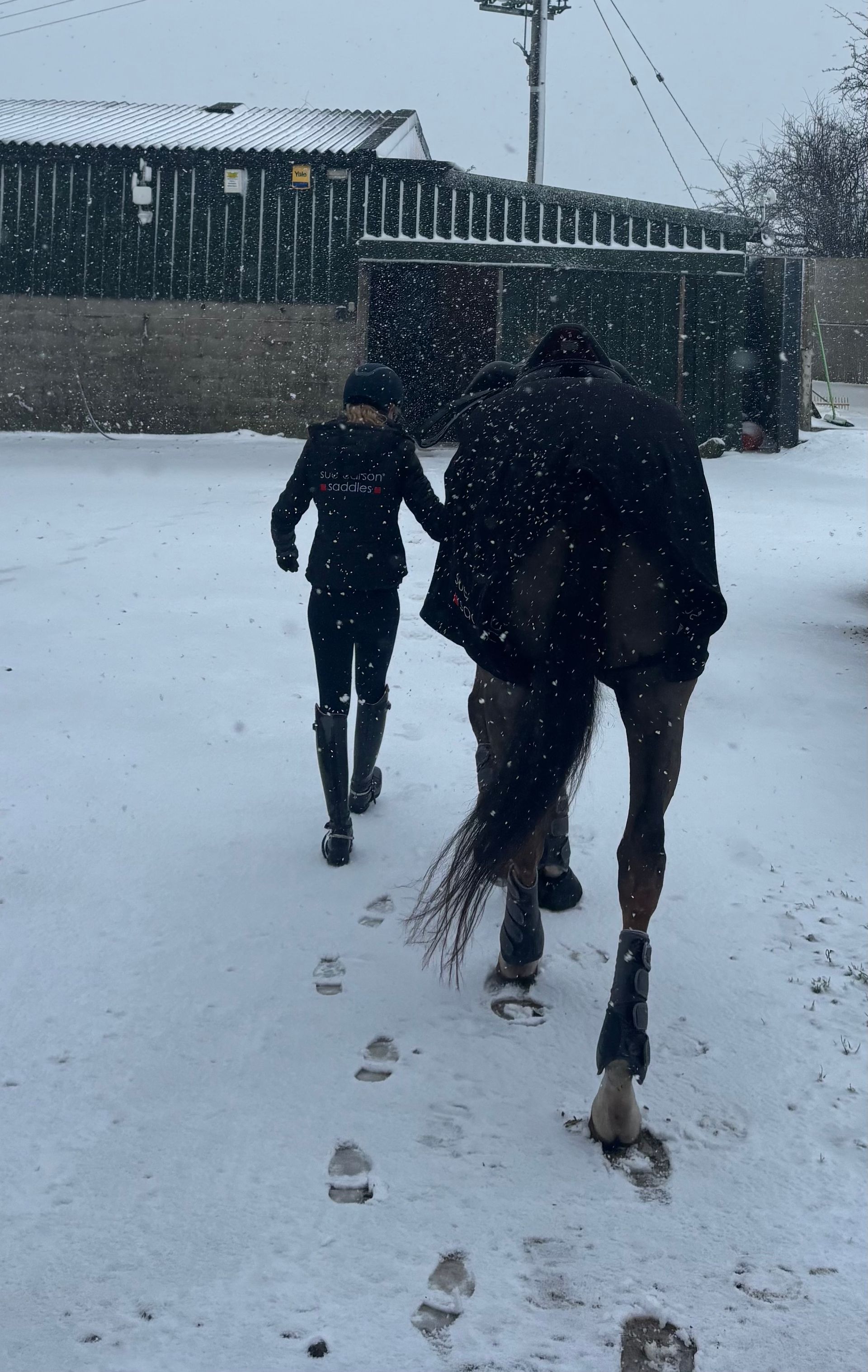Sue Carson Saddles Blog

Where has 2025 gone? How are we nearing November already? Our year has been very busy so far and it doesn't stop yet! At the start of the month we watched many combinations succeed at the PetPlan Equine Area Festival Championships and we are now looking forward to many more events coming up in November. Check out our featured Product of the Month, a perfect Autumn wardrobe addition or for a spot of early Christmas shopping!

A sunny start to the week didn't last for long as the weekend came along and Storm Amy made an appearance. Sunshine, storms and smiles were observed over the five days of dressage, with 32 titles in contention, from Prelim to Inter II, including freestyles, and over 800 tests were ridden across four arenas. We were delighted to see many of our customers had qualified for this prestigious event and were in with a chance to contest many of the titles on offer.

We returned to the Lemieux National Dressage Championships at Somerford Park, Cheshire last weekend where a number of very heavy downpours and torrential winds didn't stop many fabulous combinations from shining. With 34 national titles in contention, from Prelim to Grand Prix, including freestyle and young horse classes, it was a busy four days with over 700 tests ridden across three arenas. We were delighted to see many of our customers had qualified for this prestigious event and were in with a chance to contest many of the titles on offer.

The occasional April shower did not dampen the spirits at the NAF Five Star Winter Dressage Championships and Petplan Equine Winter Area Festival Championships held at Addington Equestrian, Buckinghamshire. With 44 national titles in contention, from Prelim to Inter I, including freestyles, it was a busy five days with over 1000 tests ridden across three arenas. We were delighted to see many of our customers had qualified for this prestigious event and were in with a chance to contest many of the titles on offer.

The clocks have sprung forwards and spring 🌷 is in the air. The event season is well underway and the hunt season has drawn to a close. We are preparing for our first tradestand of the 2025 season and look forward to seeing many familiar faces at some of the most prestigious events in the British equestrian calendar.

Leather is a perishable material, if it is not cleaned regularly and taken care off the life expectancy is greatly reduced. Colour loss and premature aging of stitching and leather are factors contributed to by lack of maintenance. The leather used to make all Sue Carson Saddles products, from saddles to bridles and knee boots to webbers, needs to be carefully maintained to ensure it remains soft and supple for years to come. We recommend not to use substances which contain alcohol or detergents to clean your Sue Carson Saddles leather goods. In order to keep leather products looking and feeling their best, Sue Carson Saddles have developed a natural leather cleaning balm, which comes with the assurance to increase the life expectancy of all new Sue Carson Saddles leather products. About our Leather Balm Sue Carson Saddles Natural Leather Balm is made in the UK using all natural ingredients including pure beeswax and essential oils, leaving your leather hydrated, protected and gleaming! The unique blend features a citronella scent which contributes as a fly repellent during summer months. Lack of maintenance, damp conditions, sun damage, extreme temperature and sweat are the most common causes of leather becoming dry, cracked and discoloured which in turn reduce the longevity of any leather product. Daily cleaning and maintenance is highly recommended to enhance your products appearance, leaving it soft and supple for years to come. For Best Results For the best results we recommend wiping your leather product over with a tepid damp sponge to remove any hard dirt and sweat. Leave the leather to dry naturally and apply your Sue Carson Saddles Leather Balm sparingly with a dry sponge. For added shine buff with a clean cloth or soft brush.

As the evenings are getting lighter and the worst of the winter weather is hopefully over, we look forward to what spring has in store. With fresh grass coming through and an increase in workload it is a crucial time of the year to get your saddles checked before the season ahead of you. Ensure your horses ultimate performance by using a Tixerant Girth with your Sue Carson Saddle and beat the price increase due in April. Get ready for the year ahead by planning your days out, check out where we will be on tour this year!

It is widely accepted that in wild horse populations there are seasonal fluctuations in body weight, predominantly due to the availability of food. There is generally more food available from spring through to autumn than there is over winter, resulting in weight gain and fat store development, which is then utilised over the winter months as a source of energy. In the domestic horse population these variations in the fat stores may be less dramatic as their food intake and body condition are more closely monitored and controlled, however research has shown that the fat stores do increase over the spring and summer in many horses. Horses that are in higher intensity training or that undergo prolonged exercise over the summer months compared to the winter months may experience a reduction in their fat stores, this is because they will utilise the fat stores for energy which has built up during the time of lower intensity exercise or if they have had a winter break. There is a lot of focus on preventing your horse or pony from becoming overweight in spring and summer to reduce the risk of health issues such as Laminitis, however very little attention is drawn to the effects that these seasonal changes in the fat stores and muscle mass from inconsistent exercise regimes have on saddle fit, which has a direct influence on horse welfare and performance. With the limited research available, it shows that the seasons have a significant influence on back measurements of horses, with a narrowing of the measurements over the winter months (October-February) and broadening out again from March onwards. The changes in seasons frequently reflect a change in the exercise regimes. The intensity, duration and frequency of training are all contributing factors to horses back measurement changes through fluctuations in muscle mass as a response to exercise. It is imperative to consider saddle fit when there are changes in exercise, feeding and management of horses, which will often occur as the seasons change. Saddle fitting is a process requiring attention to detail and patience to ensure optimal results. A thorough assessment of both horse and rider should be undertaken to understand the whole picture and is a process which should not be rushed. Understanding any veterinary, physiotherapy, osteopathy and farrier history highlights any particular areas requiring more maintenance, which in turn may impact how the horse moves under saddle. It is also important to understand any medical history relating to the rider. As more research is being undertaken, findings are starting to show that asymmetric riders are causing asymmetries in horses, which will have a direct impact on saddle fit as the saddle is an interface between the horse and rider.
2024 was a year of growth and celebration for Sue Carson Saddles. We expanded our saddle range with the launch of two innovative new dressage saddles. Our talented team of horses achieved some impressive results with multiple Area Festival wins and championship placings. We were incredibly proud to see so many of you at various championships and to be part of your journeys to success! We enjoyed connecting with you all at many prestigious events and hope to do the same again this year. We have exciting plans in store for 2025, stay tuned for updates!

Often the girth is completely overlooked, or at most it’s selected for its colour, appearance or the best aesthetic match to the saddle.This post will look specifically at one type of girth, the short length girth, almost solely used for dressage saddles and now widely used on jump or event saddles.

There is a whole army of competitive riders out there who have perfected the art of travelling and competing alone with their horse. They don’t have the luxury of a regular groom, or family and friends to support, assist or simply provide some moral back up.
We’ve handpicked 7 top tips to make your life easier if you are a “solo” competitor, or if you’ve never ventured out on your own, hopefully this will make it seem less daunting.

Where has 2025 gone? How are we nearing November already? Our year has been very busy so far and it doesn't stop yet! At the start of the month we watched many combinations succeed at the PetPlan Equine Area Festival Championships and we are now looking forward to many more events coming up in November. Check out our featured Product of the Month, a perfect Autumn wardrobe addition or for a spot of early Christmas shopping!

A sunny start to the week didn't last for long as the weekend came along and Storm Amy made an appearance. Sunshine, storms and smiles were observed over the five days of dressage, with 32 titles in contention, from Prelim to Inter II, including freestyles, and over 800 tests were ridden across four arenas. We were delighted to see many of our customers had qualified for this prestigious event and were in with a chance to contest many of the titles on offer.










